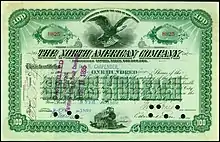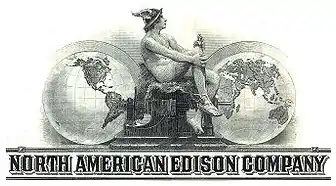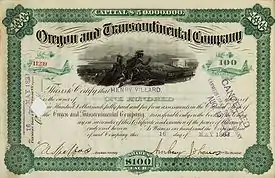North American Company
The North American Company was a holding company incorporated in New Jersey on June 14, 1890, and controlled by Henry Villard, to succeed to the assets and property of the Oregon and Transcontinental Company.[1][2] It owned public utilities and public transport companies and was broken up in 1946, largely to comply with the Public Utility Holding Company Act of 1935.

Holdings
In 1889 New Jersey passed legislation to facilitate the control of other companies by another corporation with a goal of encouraging trusts to convert into holding companies and relocate to that state.[3] To take advantage of these expanded corporate powers, in 1890 Oregon and Transcontinental, which was an Oregon corporation, re-incorporated as a holding company in New Jersey and became the North American Company.[3]
By 1940, North American was a US$2.3 billion holding company directly and indirectly heading up 80 companies. It controlled ten major direct subsidiaries in eight of which it owned at least 79%. Three of the ten were major holding companies:[4]
- Union Electric Company of St. Louis, Missouri[5]
- Washington Railway and Electric Company
- North American Light and Power Company
Four of the ten direct subsidiaries were operating companies:
- Cleveland Electric Illuminating Company[6]
- Pacific Gas and Electric[7]
- Detroit Edison Company[8]
- Wisconsin Electric Power Company[9][10]
The remaining three of the ten direct subsidiaries were:
- North American Utility Securities Corporation
- West Kentucky Coal Company
- 60 Broadway Building Corporation
At various times during its existence, North American also owned substantial interests in these other companies as well:
- The Milwaukee Electric Railway and Light Company: Formed in 1896 as a subsidiary of the North American Company. By 1929, it operated within North American Company along with Wisconsin Electric Power Company, which became the consolidated name of the two operating companies in 1938. It now belongs to Wisconsin Energy Corporation (NYSE: WEC)[10]
- Capital Transit: Formed on December 1, 1933 in Washington, D.C. from merger of Washington Railway, Capital Traction, and Washington Rapid Transit. North American owned it through its holding company subsidiary, Washington Railway and Electric Company, which in turn was the holding company for the merged lines, owning 50% of Capital Transit.[11]

- Potomac Electric Power Company[12]
- Cincinnati Gas & Electric Company[13]
- Union Light, Heat and Power of Covington, Kentucky
- Northern Natural Gas Company
- Butte Electric and Power Company
- Laclede Gas Company[14]
- Edison Securities Corporation
- Wired Radio, Inc. (Muzak)
- North American Edison Company
North American Company was broken up by the Securities and Exchange Commission, following the United States Supreme Court decision of April 1, 1946.[4]
Dow Jones Industrial Average

North American's stock was one of the twelve component stocks of the May 1896 original Dow Jones Industrial Average,[15] but it was replaced later that same year. In 1928, when the number of stocks comprising the DJIA was increased to 30, North American was re-added to the list but was replaced again in 1930. The two periods when it was a component were:
- May 26, 1896 – August 26, 1896, replaced by U. S. Cordage
- October 1, 1928 – January 29, 1930, replaced by Johns-Manville
See also
- John I. Beggs (former director)
- Clement Studebaker, Jr. (chairman of North American Light and Power Co)
References
- "Talk of a new company; The report on Oregon and Transcontinental. The present charter declared not adapted to the corporation's successful development". The New York Times. November 23, 1889. p. 3. Retrieved 2008-10-24.
- "Under a Brand-New Name; But It Is The Oregon And Transcontinental Company. The Very Extensive Powers Given To The North American Company By Its New-Jersey Charter". The New York Times. June 16, 1890. p. 5. Retrieved 2008-10-24.
- Yablon, Charles M. (2007). "The Historical Race Competition for Corporate Charters and the Rise and Decline of New Jersey: 1880-1910" (PDF). Iowa Journal of Corporation Law. University of Iowa. 32 (2): 339–340. Retrieved July 17, 2012.
- North American Co. v. Securities and Exchange Commission, 327 U.S. 686 (1946). FindLaw.com
- Standard & Poor's Stock Guide, formerly NYSE: UEP, now part of Ameren Corp. NYSE: AEE
- Standard & Poor's Stock Guide, formerly NYSE: CVX, then merged with Toledo Edison (formerly NYSE: TED) to form holding company Centerior Energy (formerly NYSE: CX), then merged with Ohio Edison Company (formerly NYSE: OEC) to form holding company FirstEnergy Corporation NYSE: FE
- Standard & Poor's Stock Guide, NYSE: PCG
- Standard & Poor's Stock Guide, formerly NYSE: DTE, then moved to holding company DTE Energy, same ticker
- Standard & Poor's Stock Guide, formerly NYSE: WPC, then moved to holding company Wisconsin Energy Corp. (formerly NYSE: WEC), then merged with Northern States Power (formerly NYSE: NSP) to form holding company Primergy Corp.
- Wisconsin Energy Corporation, History, wisconsinenergy.com
- March, Charles E. (August 1934). "The Local Transportation Problem in the District of Columbia". The Journal of Land and Public Utilities Economics. University of Wisconsin Press. 10 (3): 275–290. doi:10.2307/3139173. JSTOR 3139173.
- Standard & Poor's Stock Guide, now a unit of Pepco Holdings NYSE: POM)
- Standard & Poor's Stock Guide, NYSE: CIN, then moved to holding company Cinergy Corp., same ticker
- Laclede Gas Company, 1857-2007; Standard & Poor's Stock Guide, (NYSE: LG) became a wholly owned subsidiary of The Laclede Group, Inc., same ticker. Along with North American, the Laclede Gas Light Company was also one of the original 12 stocks in the Dow Industrial Average.
- What happened to the original 12 companies in the DJIA?, djindixes.com Archived 2008-09-19 at the Wayback Machine